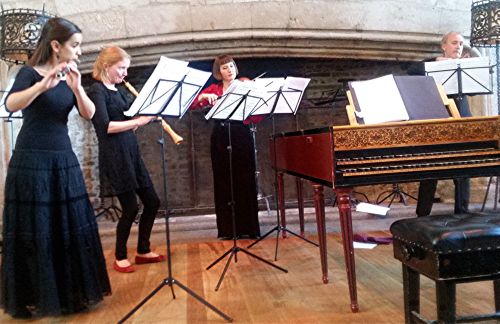 United Kingdom Bach & Sons: Persephone Gibbs (leader), Frances Norbury (oboe), Marta Gonçalves (flute) Devon Baroque / Jonathan Watts (director), Great Hall, Dartington. 11.5.2014 (PRB)
United Kingdom Bach & Sons: Persephone Gibbs (leader), Frances Norbury (oboe), Marta Gonçalves (flute) Devon Baroque / Jonathan Watts (director), Great Hall, Dartington. 11.5.2014 (PRB)

C P E Bach: Symphony in G major, Wq.182:1
W F Bach: Harpsichord Concerto in A minor, F45
J C Bach: Quintet in G major for oboe, flute, violin, viola and bass continuo, Op 11 No 2
J S Bach: Violin Concerto in E major, BWV 1042
Orchestral Suite No 2 in B minor, BWV 1067
J C F Bach: Sinfonia in D minor, Wf 1:3
J S Bach: Double Concerto for oboe/violin in C minor, BWV 1060
In his obituary for his father in 1754, Carl Philipp Emanuel Bach wrote: ‘Johann Sebastian Bach belongs to a family whose love and aptitude for music seems like a gift accorded by Nature in common to each of its members.’ Clearly, while Carl Philipp Emmanuel was perhaps seeking, to bask in his family’s reflected glory somewhat, there is little doubt that his claim is most valid – or, as German-born musicologist Christoph Wolff puts it in his Bach: Essays on His Life and Music (Cambridge,1991), ‘The most important musical family of all time’.
So, if you’re an ensemble specialising in the Baroque period, then basing an entire concert on the music of this one particular North German family is like manna from heaven – and an especially large dose at that. While, of course, it would still be virtually impossible to say that any one example from the offspring could approach the inimitable mastery of form and sheer exuberance of the father, there is still a great deal to enjoy in the often quite experimental and forward-looking music of his sons. Returning once more to the splendid surroundings and acoustic of the Great Hall, Dartington, ‘Bach & Sons’ gave leading period-instrument ensemble, Devon Baroque, an ideal opportunity to combine three of Father Bach’s familiar works with music from four of his children. Carl Philipp Emmanuel’s Symphony in G major provided an ideal opening, where taut and responsive playing in the outer movements was matched by sensitive and idiomatic treatment in the Poco Adagio, interestingly cast in the slightly unconventional key of E major. The gigue-like finale provided an ideal opportunity for the players’ natural exuberance, and to which they all responded accordingly.
f Wilhelm Friedemann’s Harpsichord Concerto in A minor wasn’t especially distinguished in itself, given that it is also not an overly extrovert piece, it nevertheless gave director Jonathan Watts a perfect opportunity to put his instrument through its paces, which he did with ample dexterity, neat articulation and sufficient panache to bring it ultimately to life.
Johann Christian’s Quintet in G provided a welcome insight into contemporary chamber music, in which the combined resources of oboist Frances Norbury, flautist Marta Gonçalves, Persephone Gibbs (violin and leader), Steve Gleed (viola), and Barbara Degener (cello continuo) made light work of the work’s charm and melodic invention, and all with a well-studied concern for effective linear interplay in each of its two lively movements. Johann Christoph Friedrich’s Sinfonia in D minor is somewhat more backward-looking than Johann Christian’s oeuvre, but his writing, showing traits of both his father’s high baroque, as well as the developing gallant style, again proved eminently well-suited to Devon Baroque’s distinctive sound and contemporary playing practices. Father Bach’s contribution to the proceedings began with his Violin Concerto in E. Here, Gibbs led with secure authority, but without unduly dominating the performance. Technical mastery in the outer movements was finely complemented by the soulfully-sung aria in the central Adagio. Devon Baroque had already given a most effective performance of Messiah, with just two voices to each part, and combining for the choruses. The effect at the time was quite breath-taking, so now coming up with a virtual ‘chamber’ version of the Orchestral Suite No 2 in B minor already had a worthy precedent. In the event, the result worked a treat in each movement, fast or slow, with Gonçalves’s totally stylish and highly-accomplished playing sufficiently able to lead the performance, without the significantly less-penetrating sound of the Baroque flute ever being swamped by the accompanying orchestral forces. Johann Sebastian’s final involvement was an extremely polished performance of his Double Concerto for Oboe and Violin, where Norbury and Gibbs proved ideally-matched protagonists, playing with great onward motion and ensuring that the composer’s characteristic driving rhythms never flagged in the outer Allegros, while delivering the central Adagio with heartfelt emotion. Yet again, Devon Baroque has come up trumps with this highly-effective mix of the known and the unknown, all superbly played in authentic fashion, and greatly enhanced by Watts’s understated, yet totally assured and informed direction
. Philip R Buttall